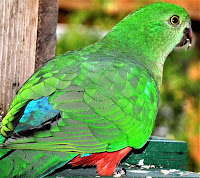The Australian King Parrot, this brightly coloured, cheeky, yet friendly bird is a regular in many back yards. They can become very tame to the extent that hand feeding is quite a regular interaction, especially if you add the right bird seed to your shopping list. In fact a neighbour of mine used to hand feed a group of King Parrots with her two cats not taking a blind bit of notice, sitting at her feet nor did the birds, they were in for a good feed. King Parrots then are fun to watch, but a word of warning, they love young green tomatoes, so if you are growing them and you want to actually eat any cover them early!
The Australian King Parrot endemic to eastern Australia from Cooktown in Queensland to Port Campbell in Victoria. Found in humid and heavily forested upland regions including eucalyptus wooded areas in and directly adjacent to subtropical and temperate rainforest. They feed on fruits and seeds gathered from trees or on the ground.
Did you know that although King-Parrots appear distinctly red and green to humans, when viewed under ultraviolet light, some feathers on the wings appear with a prominent yellow glow. Many birds have four types of cone in their retina, (compared to only three in humans) and see into the ultraviolet wavelengths.
Facts and Figures: Minimum Size: 41cm Maximum Size: 43cm Average size: 42cm
Average weight: 212g Breeding season: September to January Clutch Size: 5
Incubation: 20 days Nestling Period: 35 days Scientific Name: Alisterus scapularis
Description: Male Australian King-Parrots are the only Australian parrots with a completely red head. Females are similar to males except that they have a completely green head and breast. Both sexes have a red belly and a green back, with green wings and a long green tail. King parrots are normally encountered in pairs or family groups.
Similar species: The adult Crimson Rosella, Platycercus elegans, is similar to the male Australian King-Parrot, but differs by having blue cheeks, shoulders, and tail, a whitish, rather than red, bill and a dark eye. Immature Crimson Rosellas also differ from female and immature King-Parrots by having blue cheeks, a whitish bill and a more yellow-green rather than dark green colouring.
King-Parrots are usually found in rainforests or wet sclerophyll forests where they are largely sedentary, and mostly forages in trees for seeds and fruit. King-Parrots lay their eggs on a bed of decayed wood-dust at the bottom of a deep hollow in the trunk of a tree. Often the entrance is high in the tree (10 m) but the eggs are near the ground (0.5 m).
The King-Parrot appears to be increasing in abundance in well-treed suburbs. In urban areas it feeds at artificial feeding stations and fruiting trees, and often is blamed for taking a free feed in local or back yard veggie gardens.
Colourful, cheeky, and with a piercing song once they get going, indeed one which can be imitated quite easily with a little practice. I enjoy their company.











No comments:
Post a Comment